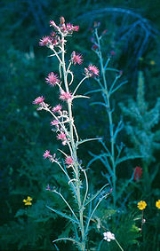
Cirsium douglasii
Encyclopedia
Cirsium douglasii is a species of thistle
known by the common names Douglas' thistle and California swamp thistle. It is native to the central coast and northern California
ranges, foothills, and plateaus, and adjacent parts of southern Oregon
and northwest Nevada
. It grows in wet places in a number of types of habitat.
.
The inflorescence
is a cluster of several flower heads
surrounded by small leaves. Each flower head is up to 3 centimetres (1.2 in) long and lined with purple-tipped spiny phyllaries
. The head contains purple or white flowers. The fruit is a dark-colored achene
2–4.5 mm (0.078740157480315–0.177165354330709 in) long/diameter with a pappus
which may reach 2 centimetre (0.78740157480315 in) in length.
Cirsium
Cirsium is a genus of perennial and biennial flowering plants in the Asteraceae, one of several genera known commonly as thistles. They are more accurately known as Plume thistles. These differ from other thistle genera in having feathered hairs to their achenes...
known by the common names Douglas' thistle and California swamp thistle. It is native to the central coast and northern California
California
California is a state located on the West Coast of the United States. It is by far the most populous U.S. state, and the third-largest by land area...
ranges, foothills, and plateaus, and adjacent parts of southern Oregon
Oregon
Oregon is a state in the Pacific Northwest region of the United States. It is located on the Pacific coast, with Washington to the north, California to the south, Nevada on the southeast and Idaho to the east. The Columbia and Snake rivers delineate much of Oregon's northern and eastern...
and northwest Nevada
Nevada
Nevada is a state in the western, mountain west, and southwestern regions of the United States. With an area of and a population of about 2.7 million, it is the 7th-largest and 35th-most populous state. Over two-thirds of Nevada's people live in the Las Vegas metropolitan area, which contains its...
. It grows in wet places in a number of types of habitat.
Description
This native thistle, Cirsium douglasii, is a biennial or short-lived perennial herb growing up to 2.5 metres (8.2 ft) tall, with a branching woolly stem. The longest gray-tomentose leaves, located about the base of the plant, are up to 1 metres (3.3 ft) long. They are sometimes lobed or toothed and are borne on a spiny petiolePetiole (botany)
In botany, the petiole is the stalk attaching the leaf blade to the stem. The petiole usually has the same internal structure as the stem. Outgrowths appearing on each side of the petiole are called stipules. Leaves lacking a petiole are called sessile, or clasping when they partly surround the...
.
The inflorescence
Inflorescence
An inflorescence is a group or cluster of flowers arranged on a stem that is composed of a main branch or a complicated arrangement of branches. Strictly, it is the part of the shoot of seed plants where flowers are formed and which is accordingly modified...
is a cluster of several flower heads
Head (botany)
The capitulum is considered the most derived form of inflorescence. Flower heads found outside Asteraceae show lesser degrees of specialization....
surrounded by small leaves. Each flower head is up to 3 centimetres (1.2 in) long and lined with purple-tipped spiny phyllaries
Bract
In botany, a bract is a modified or specialized leaf, especially one associated with a reproductive structure such as a flower, inflorescence axis, or cone scale. Bracts are often different from foliage leaves. They may be smaller, larger, or of a different color, shape, or texture...
. The head contains purple or white flowers. The fruit is a dark-colored achene
Achene
An achene is a type of simple dry fruit produced by many species of flowering plants. Achenes are monocarpellate and indehiscent...
2–4.5 mm (0.078740157480315–0.177165354330709 in) long/diameter with a pappus
Pappus (flower structure)
The pappus is the modified calyx, the part of an individual disk, ray or ligule floret surrounding the base of the corolla, in flower heads of the plant family Asteraceae. The pappus may be composed of bristles , awns, scales, or may be absent. In some species, the pappus is too small to see...
which may reach 2 centimetre (0.78740157480315 in) in length.

